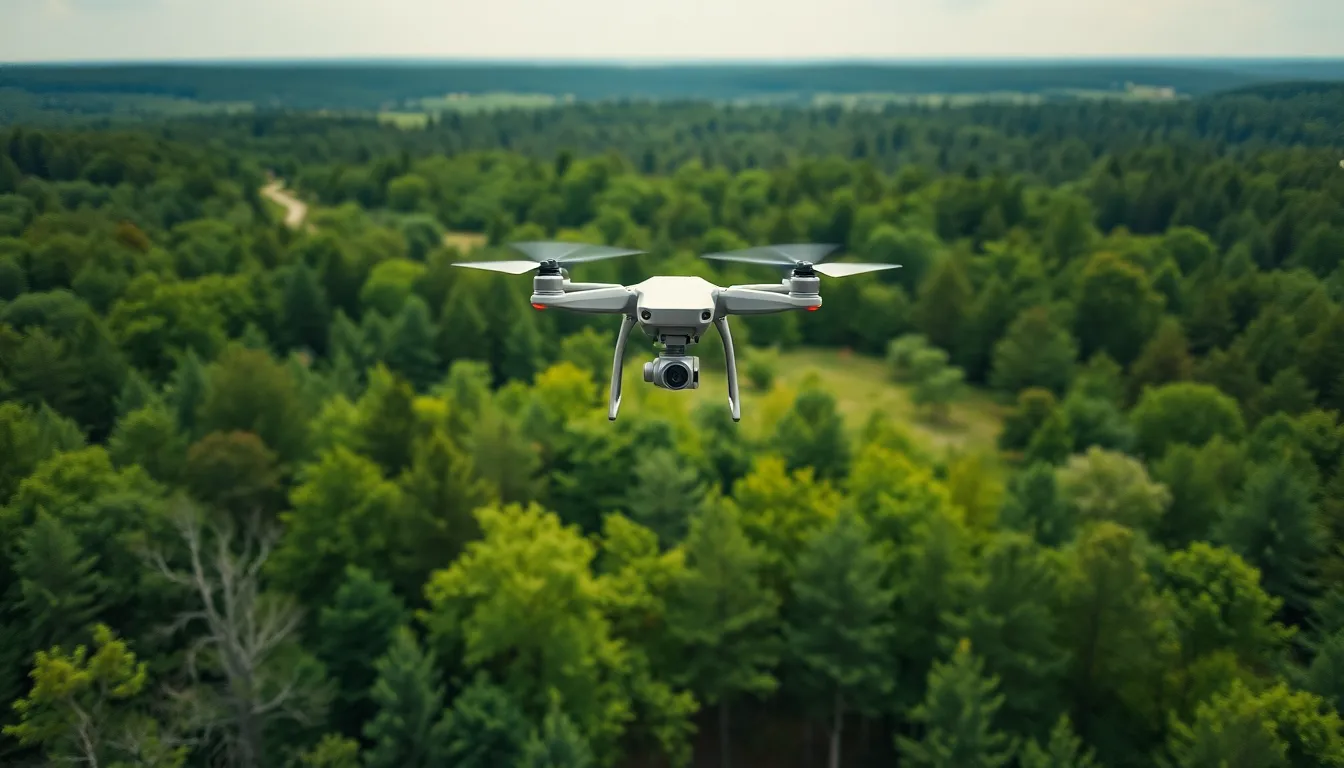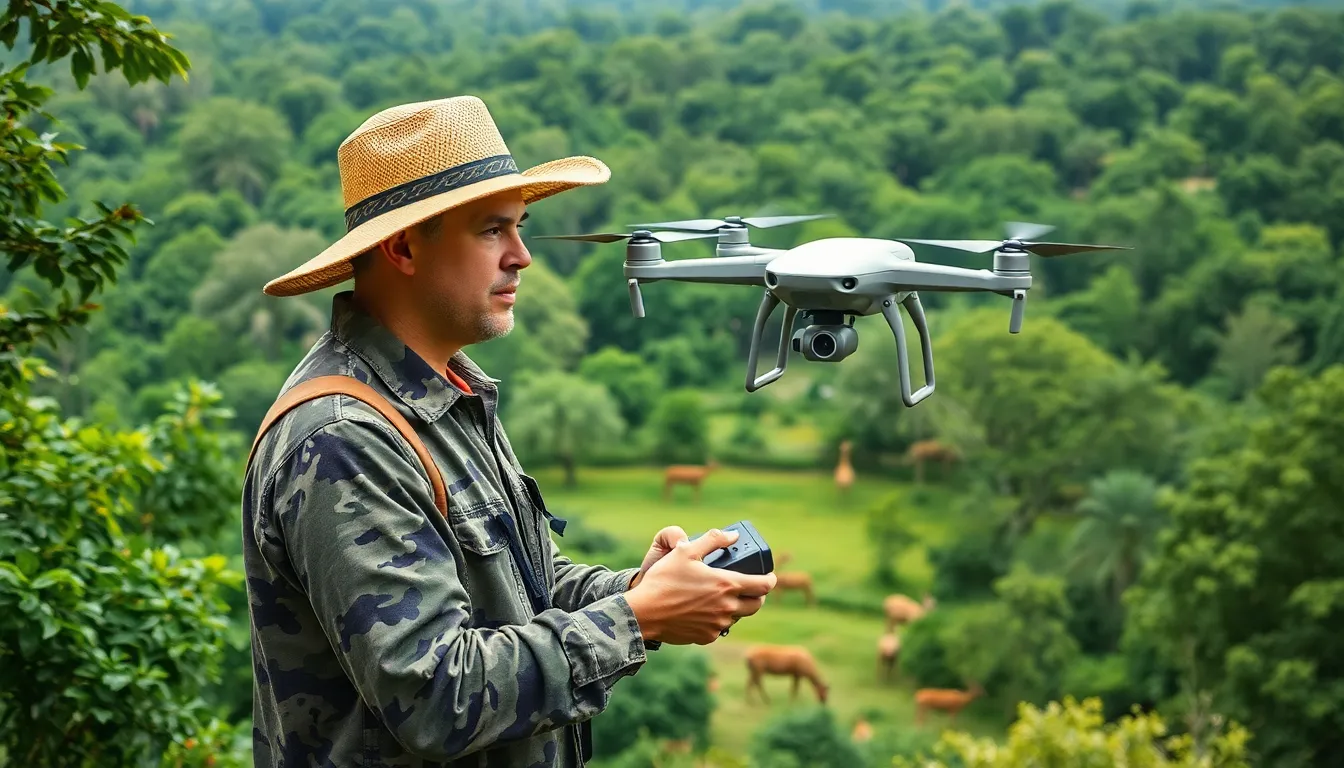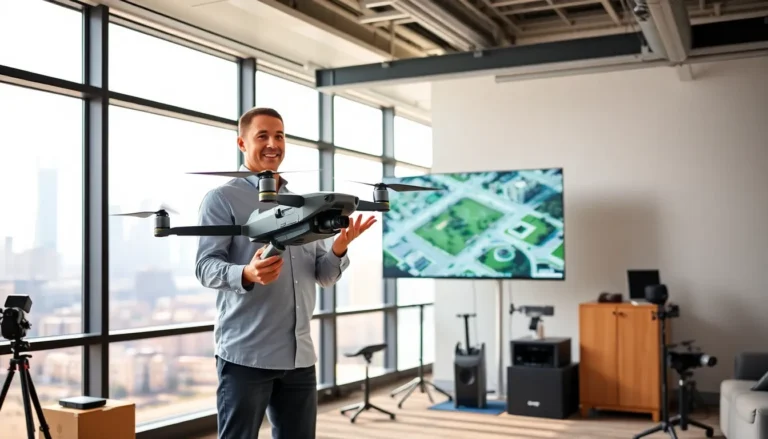Drones have taken to the skies, and they’re not just for capturing stunning vacation photos or delivering snacks. These high-flying gadgets are becoming the unsung heroes of wildlife conservation. Imagine a bird’s-eye view of a herd of elephants roaming freely or spotting endangered species without disturbing their habitat. It’s like having a superhero sidekick, but instead of a cape, it’s equipped with cameras and sensors.
With their ability to cover vast areas quickly and efficiently, drones are revolutionizing how researchers monitor wildlife. They’re the ultimate stealthy observers, giving scientists crucial data while keeping their furry subjects blissfully unaware. So, buckle up and get ready to explore how these buzzing marvels are changing the game for wildlife protection, one flight at a time. Who knew saving the planet could be so high-tech and cool?
Table of Contents
ToggleOverview of Drones for Wildlife
Drones serve as critical instruments in wildlife conservation efforts. They allow researchers to monitor animal populations, track movements, and assess habitats with minimal disruption. Equipped with high-resolution cameras and sensors, these devices gather crucial data, providing insights into animal behavior and environmental changes.
Many conservationists utilize drones for surveying inaccessible locations. Traditional methods often require extensive manpower and time, while drones cover vast areas in a fraction of the time. This efficiency translates into more accurate data collection, enhancing conservation strategies.
Drones also play a significant role in anti-poaching efforts. By providing real-time surveillance, they detect illegal activities and alert authorities swiftly. This proactive approach has proven essential for protecting endangered species from poachers and habitat destruction.
Various types of drones assist in specific conservation tasks. Fixed-wing drones excel in long-range missions, while quadcopters are ideal for detailed assessments and close-up observations. Each type offers unique advantages tailored to conservation needs.
Integration of advanced technologies, such as thermal imaging and infrared sensing, enhances drone capabilities. These technologies enable the detection of animals during nighttime or through dense foliage. Thus, researchers gain insights that would otherwise go unnoticed.
Overall, drones revolutionize wildlife conservation methods. By combining technology with ecological expertise, they offer innovative solutions to pressing environmental challenges.
Applications in Wildlife Conservation

Drones significantly enhance wildlife conservation efforts through various innovative applications. Their use leads to effective strategies for monitoring populations and assessing habitats.
Monitoring Animal Populations
Monitoring animal populations benefits immensely from drone technology. These devices capture high-resolution images and videos, providing valuable data on species counts and behaviors. Conservationists can observe animal interactions without causing stress or disruption to their natural surroundings. In 2021, studies demonstrated that drones improved accuracy in counting wildlife by up to 20% compared to traditional methods. This efficiency allows for timely interventions when populations face threats, ensuring better protection of vulnerable species.
Habitat Mapping and Assessment
Habitat mapping and assessment leverage drone capabilities to collect critical environmental data. Using specialized sensors, drones can detect vegetation changes and map terrain with precision. This detailed information helps researchers identify habitat quality and changes over time. In challenging or remote locations, drones access areas that often remain unexplored, providing insights typically lost in conventional surveys. With accurate habitat assessments, conservationists can make informed decisions about restoration strategies. Studies indicate that drone-assisted mapping reduces data collection time by approximately 70%, thus enhancing overall conservation efficiency.
Benefits of Using Drones
Drones significantly enhance wildlife conservation efforts through various advantages that streamline monitoring and protection strategies.
Cost-Effectiveness
Cost efficiency relies on drones reducing expenses tied to traditional surveillance methods. Deploying drones cuts fuel and labor costs associated with ground-based surveys. A study revealed data collection efficiency improves by approximately 70%, enabling researchers to allocate resources more effectively. With high-resolution cameras, drones also minimize the need for costly equipment rentals, making it easier to gather crucial information across extensive areas. Long-range fixed-wing models and agile quadcopters offer flexible options for different missions, ensuring better financial management of conservation projects.
Reduced Human Disturbance
Minimizing human interference becomes vital for effective wildlife monitoring. Drones operate discreetly, allowing researchers to observe animal behavior without causing stress or disruption. Many species show heightened sensitivity to human presence; therefore, using drones facilitates unobtrusive assessments. Researchers note a significant reduction in observation bias, contributing to more accurate data collection. Conservationists can gather vital ecological information in sensitive habitats, preserving the integrity of environments while maintaining efficient monitoring practices. This approach fosters healthier animal populations and ecosystems, aligning conservation goals with natural behaviors.
Challenges and Limitations
Drones in wildlife conservation face various challenges and limitations that affect their overall effectiveness. Recognizing these barriers helps improve future applications.
Legal and Ethical Concerns
The deployment of drones raises legal and ethical issues concerning wildlife protection. Regulations governing airspace and privacy limits often restrict drone use in certain habitats. Conservationists must navigate laws that vary by region, making compliance complex. Additionally, ethical considerations arise regarding animal welfare; disturbances caused by drones may stress wildlife. Striking a balance between technological advancement and ethical responsibility remains vital for effective conservation efforts. Engaging with local communities and stakeholders can help address these concerns, promoting collaboration in wildlife protection initiatives.
Technical Limitations
Technical limitations hinder drones’ effectiveness in wildlife monitoring. Battery life often restricts flight duration, especially during extensive surveys. Limited range affects remote area accessibility, complicating data collection. Weather conditions also pose challenges; strong winds or rain can disrupt operations. While advanced sensors enhance detection capabilities, they may not perform optimally in all environments. Additionally, data processing can be time-consuming, requiring sophisticated software and expertise. Addressing these technical hurdles will enhance drones’ role in wildlife conservation, paving the way for more reliable and efficient data collection.
Future Trends in Drones for Wildlife
The future of drones in wildlife conservation is poised for significant advancements. Emerging technologies like artificial intelligence promise to enhance data analysis processes. Researchers increasingly integrate machine learning algorithms, enabling real-time identification and monitoring of wildlife species. Enhanced automation allows drones to operate independently, reducing the need for human intervention during critical surveys.
Innovations in battery technology extend flight times, allowing drones to cover larger areas without frequent recharging. Additionally, development in lightweight materials is making drones more adaptable and efficient. These improvements in design promote greater maneuverability in challenging terrains.
Integration of communication technology offers the potential for more coordinated efforts among conservation teams. Through real-time data sharing, researchers can collaborate effectively, addressing conservation challenges more swiftly. Drones equipped with GPS technology provide precise tracking of animal movements, yielding insights that inform conservation strategies.
Utilization of multi-spectral and hyperspectral imaging enhances environmental monitoring. This technology captures a broader range of data related to vegetation health, which assists in determining habitat quality. Gathering this data provides valuable input for restoration projects and policy-making.
Collaboration among technology companies, conservation groups, and policymakers fosters a more sustainable approach to wildlife protection. Investment in drone technology encourages advancements while ensuring that ethical considerations remain priorities. Legal frameworks must adapt to accommodate innovations, balancing conservation needs with wildlife welfare.
The commitment to ongoing research and development signifies a promising future where drones optimize wildlife conservation efforts. Monitoring endangered species becomes more efficient, and the understanding of ecosystems deepen. Continuous improvement in drone technology will ultimately lead to more effective strategies for preserving biodiversity.
Drones are reshaping wildlife conservation by offering innovative solutions that enhance monitoring and protection efforts. Their ability to gather crucial data with minimal disruption allows researchers to make informed decisions that directly impact endangered species. As technology continues to advance, the integration of AI and improved imaging will further refine these capabilities.
The collaboration between conservationists and tech developers is vital for overcoming existing challenges and maximizing the benefits of drones. With ongoing advancements, the future looks bright for wildlife conservation, promising more effective strategies to safeguard biodiversity. Drones not only streamline data collection but also deepen the understanding of ecosystems, making them indispensable in the fight for wildlife preservation.





